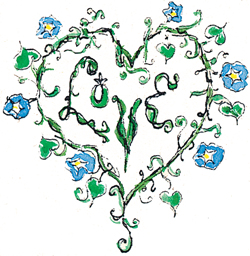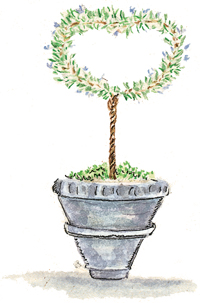
“A child’s world is fresh and new and beautiful, full of wonder and excitement.”
—Rachel Carson, A Sense of Wonder

Twenty years ago on a sizzling hot day, I watched a grown-up teach a small group of children about gardening. The kids fidgeted and looked longingly toward the playground. They barely heard the teacher’s instructions as he said, “Dig a square of soil, mark some straight rows with string, drop each seed into a hole, cover, water, and move on to the next row.” I wanted to dive into the midst of the kids and share with them the countless miracles that could be found in a garden. And how every seed held the promise of flowers and fruits and all their attendant critters. I vowed then to someday write and illustrate a book that not only instructed, but also opened the eyes of both grown-ups and children to the many wonders in their own backyard.
I invite you to sit down with your children and get acquainted with my book. Turn to the Gardening Basics chapter (see here), which is written for the novice as well as the seasoned gardener, where you’ll find easy-to-follow instructions about planning, planting, and caring for your garden. My explanations about soil pH and other frequently asked questions are simply worded so that your youngster will understand the how AND the why of earth-friendly garden practices. Special projects in the Basics include making homemade seed tapes, building a simple wire compost bin, and constructing a cozy home for your own family of red earthworms. One of my favorite projects is assembling an Explorer’s Kit (see here) and using it every day and night in the garden. This assortment of inexpensive equipment adds another exciting dimension to your garden adventures.
The heart of this book is a collection of interactive “idea,” or theme, gardens designed and tested for the inspiration and joy of children everywhere. Most plants in these gardens are easy-to-grow annuals which are suitable for most zones in the United States. They can be planted in June and enjoyed throughout the summer and early fall.
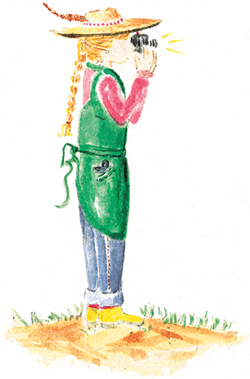
Rather than focusing on a grownup’s concept of design, the gardens here are combinations of plants specifically chosen to captivate kids and engage all five of their senses. The nucleus of each theme garden is a “Discovery Walk,” a daily (or nightly) exploration of nature in your own backyard. At the end of each chapter are suggestions for recipes, craft projects, and activities to make with your harvest.
The Pizza Patch, Snacking & Sipping Garden, Mother Nature’s Medicine Chest, and Zuni Waffle Garden introduce children to the incomparable taste of homegrown foods and drinks. Although these gardens are filled with edible plants, not all parts of every plant are edible. For example, while potatoes and tomatoes are edible, their stems, flowers, and leaves are poisonous. Teach your kids never to sample anything in their gardens until they check with you.
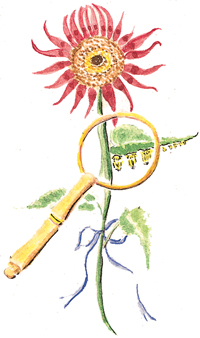
The Sunflower House, Moon Garden, Flowery Maze, and Garden of Giants each provide a “living” hideaway, a private place every child needs. Instead of the confining walls of a traditional playhouse, kids are surrounded by myriad vines and flowers and all the fascinating creatures they attract. Within their enchanted havens, they can read, play, create art, daydream, and just enjoy being alone. These natural shelters allow kids to grow along with their garden.
If you don’t have enough space for one of the theme gardens described here, simply tailor it to fit your needs. My garden designs aren’t set in concrete; they’re grown in soil, so experiment, change, add to or subtract from them. Just follow the directions for planting and care requirements and your garden will thrive.
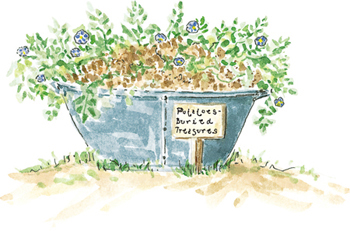
Browse through the first chapter on Top 20 Plants for Kids that I compiled from more than two decades of observations and teaching. Kids will learn to look at plants in a different way. If you don’t have space for a theme garden, let your children choose one or more of the top 20 plants for a design of their own.
For planting in small spaces, read Buckets, Boxes & Boots (see here) and you’ll find there is always a place for a garden.
The Resources (see here) provide invaluable aids for gardeners. Choose some catalogs listed in this section that look interesting to you and your kids. Contact the companies to request their most recent, publication, and ask that it be mailed to your children. Kids love to receive mail, and this will build anticipation and excitement. When the catalogs arrive, set aside some dream time for yourselves, circle any plants that intrigue your youngsters, let them cut out photographs and paste them into their journals, and make plans for the magical garden you will create together.
Since children will be touching all and eating some of the plants, gardens should never be treated with herbicides, fungicides, or pesticides. Also, avoid the use of slug and snail bait, which can harm both kids and wildlife. In many cases, handpicking insects or a forceful spray of water (kids love to do both of these tasks) is all that is required to keep your garden pest free.
Children can discover the world in the microcosm of a garden, but they need to be accompanied on their explorations by a patient and enthusiastic grown-up, an earth-mentor who will enjoy the entire process of learning, planning, and gardening together.
The eloquent author and scientist Rachel Carson wrote, “If I had influence with the good fairy who is supposed to preside over the christening of all children I should ask that her gift to each child in the world be a sense of wonder so indestructible that it would last throughout life. . . . If a child is to keep alive his inborn sense of wonder without any suck gift from the fairies, he needs the companionship of at least one adult who can share it, rediscovering with him the joy, excitement and mystery of the world we live in.” It is my hope that YOU are that one special person. I wish you an exciting journey!
